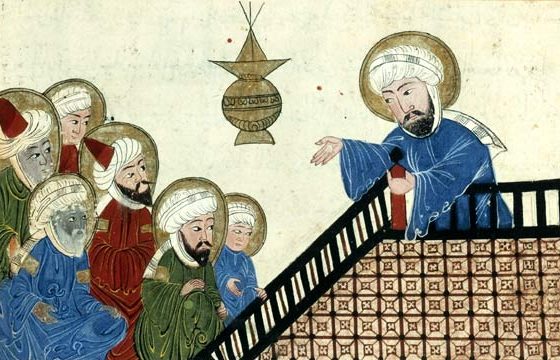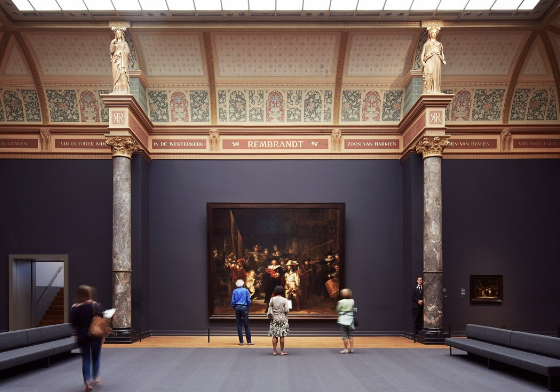Author’s note:
Ronald Reagan once said, “The closest thing to eternal life on Earth is a temporary government program.” Conversely, I would argue that “The closest thing to temporary life on Earth is a permanent online article.” Unlike books in libraries and physical newspaper archives, op-ed pieces, news coverage, and other material on the Internet can be there one day and then turn into “Page not found.”
Maddening!
Some of my articles have succumbed to Sudden URL Death. One such piece is below, originally published in January 2010 and revived here for your reading pleasure.
Ironically, several of the links that I embedded in this piece subsequently have gone dead. Thankfully, the Internet Archive’s Wayback Machine captured some before their demise. Others escaped this superlative resource and are gone with the wind.
Good luck to historians of the future who will look back on our age and find that so much that exists online today will have turned to digital dust.
NEW YORK — The Mohammed cartoon controversy just keeps on giving.
More than four years have elapsed since a Danish newspaper published images of Islam’s prophet, setting in motion events that soon culminated in deadly Muslim riots. Nonetheless, Muslim extremists are unable to put this episode behind them.
On the evening of Friday, January 1, 2010, Kurt Westergaard — an artist who drew one of those cartoons — found himself once again at the center of this imbroglio. While Westergaard locked himself inside a safe room at his home in Viby, Denmark, near Aarhus, a 28-year-old Somali Muslim extremist stood at his front door wielding a knife and an ax, which he apparently hoped to plunge into Westergaard’s flesh.
Fortunately, Danish police arrived, shot the would-be assassin in the knee and the hand, and whisked him away to heal his wounds. The erstwhile assailant, Danish officials say, belongs to the al-Qaeda-linked Somali terror group al-Shabaab. He also was arrested in Kenya last August for his role in a plot to bomb a bus depot and two hotels, including the InterContinental Nairobi, where Secretary of State Hillary Clinton addressed an African-development conference. Kenyan authorities later released him for lack of evidence, whereupon he flew back to Denmark, where he is a legal resident and had lived since age 16.
An al-Shabaab representative said the 28-year-old Danish resident was not a member of the group. “But,” the spokesman said, “We approve that he tried to kill that man, who insulted our prophet. It sends a clear signal to Danish-Somalis to act and kill that man – regardless of the price.”
Here at home, two Chicago men face federal charges in an alleged plot to bomb the headquarters building of the Danish newspaper that published these cartoons. David Headley (formerly Daood Gilani) and Tahawwur Rana are accused of conspiracy to provide material support to terrorists. Danish authorities worked with the FBI to apprehend the pair last October. Rana was apprehended at his Chicagoland home while Headley was nabbed at O’Hare Airport en route to his native country, Pakistan.
So, what exactly fuels all of this Islamic-extremist commotion?
Islamo-fascists originally got their turbans in knots as they claimed it is the height of blasphemy to depict Mohammed. They used that supposed injunction to justify death threats and violent protests that drove Scandinavian artists into police protection and killed at least 45 people around the world.
Apparently, many Muslim artists never got that memo.
Mohammed’s face abounds in Islamic art. Many of these are medieval works, but some were created in modern times. This all makes this affair’s assassination attempts, bombing plans, vandalism, embassy fires, and murders by Muslim crowds not just infantile and savage, but also highly hypocritical.
A fascinating website called Mohammed Image Archive (MIA) features dozens of paintings, engravings, miniatures, and other representations of the Muslim Prophet. They range from the ancient and reverent to the avante garde and disrespectful. This website offers a thorough view of the ways Mohammed has been portrayed across the centuries and by artists from Persia to Germany to Denmark.
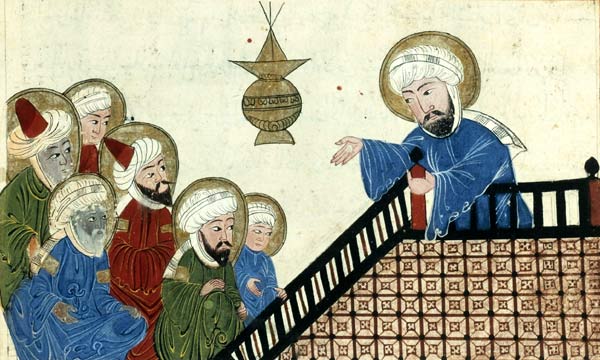
Some of these works are colorful and striking, such as this Persian or Central Asian scene of Mohammed preaching.
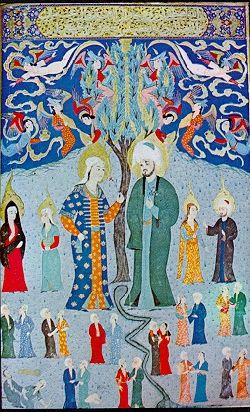
This work is called “The Ascension of the Prophet,” from Jami’ al-Tavarikh or The Universal History.
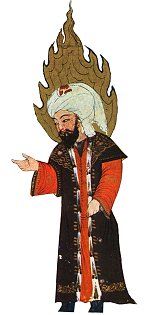
In something akin to the halo found in Christian iconography, this unidentified piece shows Mohammed’s head surrounded with flames, apparently an indication of holiness.
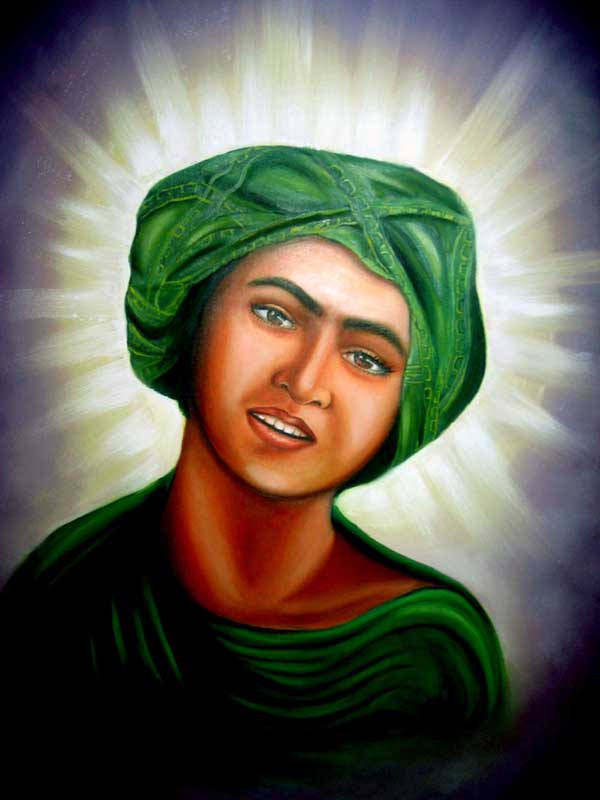
A Muslim artist named Oranus lives in Tehran, Iran. She created this bright and vibrant portrait of a young Mohammed. According to MIA, “Though this would seem to violate Islamic and Iranian law, an expert in Iranian Shi’ite customs writes in to say that this particular painting is not forbidden because it depicts a young Mohammed before he was visited by the Angel Gabriel and started receiving his visions, which means that at this stage in his life he is not yet the Prophet.”
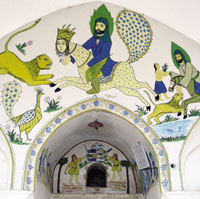
Also from Iran is this image from a mural that MIA says is on a contemporary building. It shows Mohammed riding Buraq, a creature with a woman’s face and a peacock’s tail.
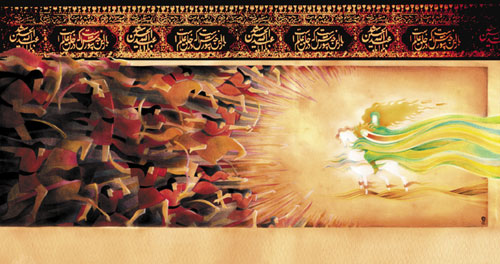
MIA observes that the photo of Mohammed in this mural appears on the website of the Iranian newspaper Hamshahri, one of the Muslim publications most incensed by those Danish images. Hamshahri, in fact, stuck it to the Danes by organizing a contest for cartoons about the Nazi Holocaust. But Hamshahri seems guilty of inconsistency, if not hypocrisy. MIA reports that the lobby of Hamshahri’s headquarters features this radiant painting in which Mohammed gloriously rides his white horse before an apparently overwhelmed army.
One of the less pious depictions of Mohammed is this one showing him reciting the Koran to a crowd.
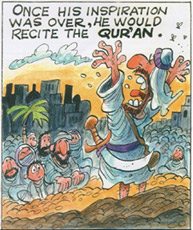
This drawing is from a comic book called Mohammed’s Believe It or Else! by an artist whose nom de plume is Abdullah Aziz. Clicking through for more information yields this chilling letter to readers:
Greetings,
It is with great regret that I must go into hiding.
This is a result of the multiple death threats I have received for my comic book, which depicts the truth about the teachings of the prophet Mohammed. I am earnestly confused about this matter. I have spoken honestly and truthfully about Islam and its teachings. All quotes in the comic book are directly from the Qu’ran and the agreed Hadiths.
Why does a religion of peace seek to kill me for being honest? What do they have to hide?
I hope to return when I am free to speak once again.
Abdullah Aziz
Abdullah Aziz’s exile in a de facto “Artist Protection Program” returns us to winter 2006’s global Muslim tantrum.
MIA includes all 12 of the now-infamous cartoons published on September 30, 2005 in Denmark’s Jyllands-Posten. They appeared together on one page and were intended to provoke discussion of what the paper’s editors considered self-censorship among Danish artists who originally refused to illustrate author Kåre Bluitgen’s book, The Koran and the Life of the Prophet Mohammed. (Bluitgen eventually found an illustrator.)
Jylland-Posten’s drawings range from the tame:
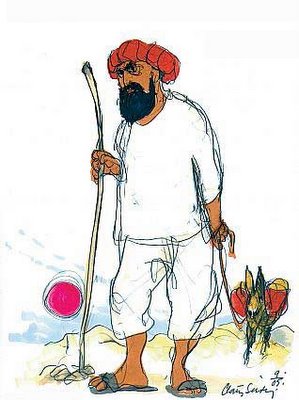
To the satirical:
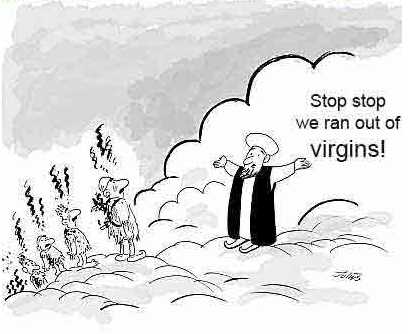
To the highly irreverent, in this case the image penned by Kurt Westergaard, who was targeted for death on New Year’s Day:
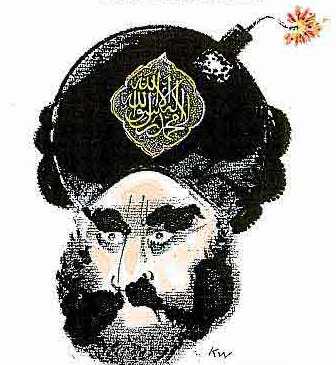
MIA dives even deeper into this story by discussing and linking to the additional images that Danish imams presented to their Middle Eastern counterparts in an effort to “document” Denmark’s alleged blasphemy and anti-Islamic attitudes. These images, which never appeared in Jyllands-Posten, supposedly were mailed anonymously to Danish Muslims. However, when the Danish newspaper Ekstra Bladet tried to interview them, Ahmad Akkari — then-spokesman for Denmark’s Islamic Faith Community (IFC) — refused to produce those supposed bias victims.
On March 24, 2006, the Associated Press reported, the IFC sacked Akkari after he secretly was videotaped discussing the idea of bombing Naser Khader, a moderate Danish Muslim legislator. In a story aired that March 23 on France 2 television, Akkari said about Khader: “If he becomes minister for foreigners, or integration, shouldn’t two guys go see him to blow him up, him and his ministry?” Akkari says his Arabic-language comments, caught on a hidden camera that February, were “a joke.” But his former employers are not laughing. “Akkari can no longer be our spokesman after these statements,” said IFC leader Kasem Said.
These far-more explosive images with which the Danish imams jetted into the Middle East (which columnist Michelle Malkin posted on her website) include a grainy black-and-white picture of a dog copulating with an unidentifiable Muslim who is praying on hands and knees. In another, poorly copied, black-and-white picture, Mohammed allegedly prays into a microphone while wearing a pig’s nose.
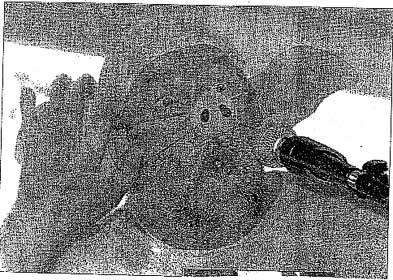
Not so fast, Ayatollah.
As NeanderNews.com reveals, this picture is exactly the same one Associated Press photographer Bob Edme snapped at summer 2005’s French Pig-Squealing Championships in Trie-sur-Baise, France. The man in this photo is not the Prophet Mohammed. He is, in fact, Jacques Barrot, a French pig-squealing contestant. For real.
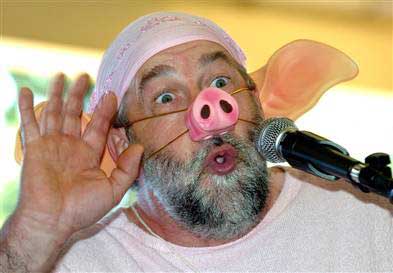
The AP covered this event, and MSNBC.com posted its story on this rural cultural event on August 15, 2005, along with Edme’s photograph.
So, Mohammed has been represented in Islamic art, from the Middle Ages right into spring 2006, when the cartoon-fueled flames erupted and killings began, despite boisterous claims to the contrary. Some of the loudest protests came from the Danish imams who virtually custom-ordered that February’s deadly riots. They, in turn, could not take the chance that Mohammed’s presence in Jylland-Posten’s drawings would yield yawns. Thus, they bamboozled their opposite numbers in the Middle East with a “sexed up” cartoon dossier in hopes their colleagues would deploy their own angry, local mobs.
It worked!
And now the blood of at least 45 people drips from the fingers of these Islamo-Scandinavian “men of peace.”
Deroy Murdock is a Manhattan-based Fox News contributor.
The opinions expressed by columnists are their own and do not necessarily represent the views of TrumpTrainNews.com

